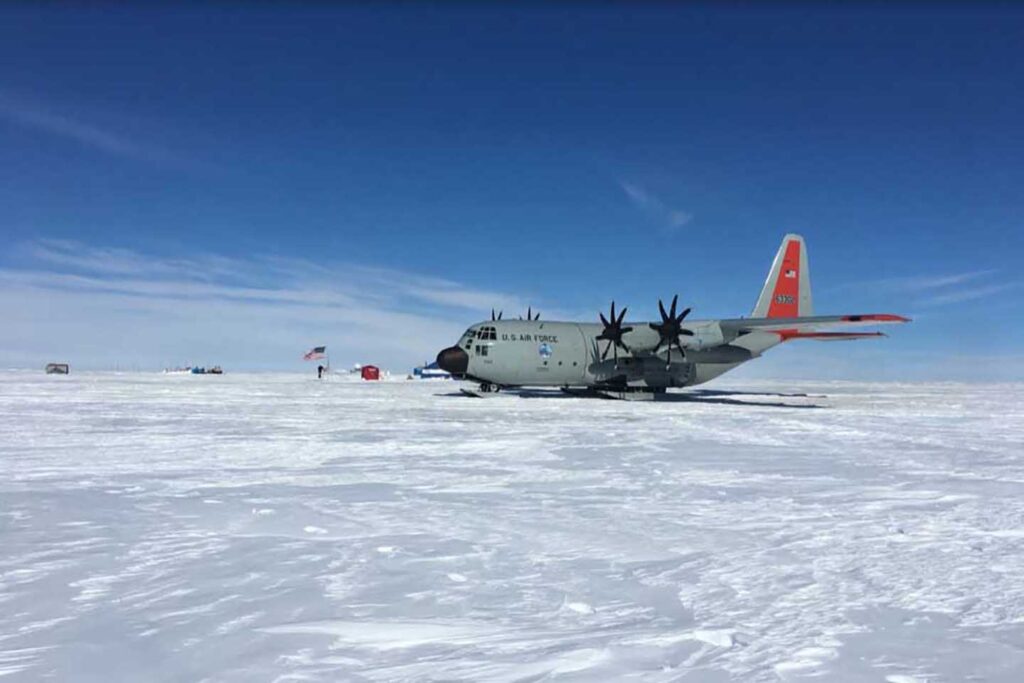An LC-130 Hercules aircraft sits on an Arctic skiway created by the 109th Airlift Wing.
THE WATCH STAFF
Defending the U.S. homeland around-the-clock from an array of threats across North America was the theme of the most recent Homeland Defense Awareness Symposium (HDAS) in Colorado Springs, which attracted more than 100 government, industry and academic participants.
Organized by the Homeland Defense Institute at the U.S. Air Force Academy, U.S. Northern Command (USNORTHCOM) and the North American Aerospace Defense Command (NORAD) on July 18-19, 2023, the annual symposium’s theme was “Homeland Defense 24-7.”
Geographically based panels and breakout sessions on the Arctic, Mexico and the Caribbean and maritime issues provided participants with a clear understanding of globally integrated layered defense, a high priority for NORAD and USNORTHCOM, and the importance of close working relationships and mutual support between allies in the domains of land, air, sea, space and cyber defense against growing Chinese and Russian threats.
Another key goal was to accelerate new concepts and capabilities to detect and respond to known and emerging threats to the homeland.
In her keynote address, Katherine Bukolt, NORAD and USNORTHCOM’s deputy director for intelligence, shared how both threats to the homeland and technology have undergone significant transformations, reshaping the security landscape in profound ways. In this era of strategic competition, where competitors are aggressively pursuing advantages in the military, information, economic and geopolitical spaces, North America is threatened from every vector and from all domains. The private sector and academia are hubs of technological innovation that are key to the development of comprehensive strategies and solutions to address emerging threats and challenges.
The geographic panels provided an opportunity for attendees to delve further into these broader themes with a more regional focus.
In the Arctic panel and a subsequent breakout session, participants discussed how climate change has opened the previously remote region to resource extraction and military activity. The U.S. and Canada can best counter this threat, principally from Russia, by even greater cooperation and integration of their security goals and partnerships, panelists said.
In the short term, U.S. agencies such as the National Oceanic and Atmospheric Administration (NOAA) vessels could anchor a presence in the region. Still, large-scale, long-term infrastructure investments are needed.
The Arctic lacks fuel storage, deepwater ports, railroads, and all-weather roads, which complicates efforts to conduct and supply military operations.
The U.S and Canada have a good reputation in the region with Indigenous communities seeking assistance and investments. Also, bipartisan support exists for strong defense programs, and the private sector has an interest in partnering with governments.
But the U.S. public doesn’t know much about the Arctic, and that has contributed to a lack of logistical investment, according to participants.
Participants pointed to Alaska’s strategic location at the confluence of three combatant commands — USNORTHCOM, U.S Indo-Pacific Command and U.S. European Command — as an opportunity for the region along with the possibility of robust public-private partnerships. Close relations with the Nordic nations should also be developed, they concluded.
Turning southward, participants agreed that close relationships with Mexico and the Bahamas are key to U.S security and provide a hemispheric advantage over competitors.
But crime, poverty and corruption threaten the region, giving the People’s Republic of China (PRC) the chance to exploit governments with weak digital security, security systems and port infrastructure.
The PRC also takes advantage of local governments’ toleration of transnational criminal organizations to engage in illegal trafficking of drugs, guns, and money to the U.S. and other Western nations.
More diverse perspectives, including women in leadership positions, are needed to help change policies in the region.
Maritime issues also received attention, especially the rapidly growing role of data and technology in securing Atlantic and Pacific Ocean approaches to the homeland.
Russian and Chinese investments in submarine technology and stealth propulsion systems have upgraded their combat capability to threaten the U.S. from international waters.
To counter this threat, the U.S. and Canada need to better track and increase domain awareness in the oceans by incorporating networks of autonomous sensors and improved computer speeds and processing.
Identifying threats and assessing intent will always be difficult, increasing the need for port and coastal surveillance. The U.S Coast Guard will play a vital role in this effort, participants said.
The symposium also featured four research presentations on Arctic defense, deterring Russian and Chinese aggression and homeland defense.
Finally, in a joint education and training workshop, NORAD and USNORTHCOM senior leaders educated the symposium attendees about the mission of their commands: to give U.S. leaders more time and greater options to address threats before they escalate to conflict.

